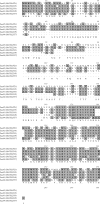The fusidic acid stimulon of Staphylococcus aureus
- PMID: 18786940
- PMCID: PMC2583067
- DOI: 10.1093/jac/dkn363
The fusidic acid stimulon of Staphylococcus aureus
Abstract
Objectives: Fusidic acid interferes with the release of elongation factor G (EF-G) after the translocation step of protein synthesis. The objective of this study was to characterize the fusidic acid stimulon of a fusidic acid-susceptible strain of Staphylococcus aureus (SH1000).
Methods: S. aureus microarrays and real-time PCR determined transcriptome alterations occurring in SH1000 grown with fusidic acid. The Staphylococcus aureus microarray meta-database (SAMMD) compared and contrasted the SH1000 fusidic stimulon with 89 other S. aureus transcriptional datasets. Fusidic acid gradient analyses with mutant-parent strain pairs were used to identify genes required for intrinsic fusidic acid susceptibility identified during transcriptional analysis.
Results: Many genes altered by fusidic acid challenge are associated with protein synthesis. SAMMD analysis determined that the fusidic acid stimulon has the greatest overlap with the S. aureus cold shock and stringent responses. Six out of nine peptidoglycan hydrolase genes making up the two component YycFG regulon were also up-regulated by fusidic acid, as were a carboxylesterase gene (est) and two putative drug efflux pump genes (emr-qac1 and macA). Genes down-regulated by fusidic acid induction encoded a putative secreted acid phosphatase and a number of protease genes. Roles for the agr operon, the peptidoglycan hydrolase gene isaA and two proteases (htrA1 and htrA2) in the expression of fusidic acid susceptibility were revealed.
Conclusions: The SH1000 fusidic acid stimulon includes genes involved with two stress responses, YycFG-regulated cell wall metabolism, drug efflux, and protein synthesis and turnover.
Figures
Similar articles
-
Molecular analysis of fusidic acid resistance in Staphylococcus aureus.Mol Microbiol. 2003 Jan;47(2):463-9. doi: 10.1046/j.1365-2958.2003.03307.x. Mol Microbiol. 2003. PMID: 12519196
-
Characterization of fusidic acid-resistant Staphylococcus aureus isolates in the community of Casablanca (Morocco).Int J Med Microbiol. 2012 Mar;302(2):96-100. doi: 10.1016/j.ijmm.2011.10.002. Epub 2011 Dec 23. Int J Med Microbiol. 2012. PMID: 22197537
-
Transcriptional profiling reveals that daptomycin induces the Staphylococcus aureus cell wall stress stimulon and genes responsive to membrane depolarization.Antimicrob Agents Chemother. 2008 Mar;52(3):980-90. doi: 10.1128/AAC.01121-07. Epub 2007 Dec 17. Antimicrob Agents Chemother. 2008. PMID: 18086846 Free PMC article.
-
Dumb and dumber--the potential waste of a useful antistaphylococcal agent: emerging fusidic acid resistance in Staphylococcus aureus.Clin Infect Dis. 2006 Feb 1;42(3):394-400. doi: 10.1086/499365. Epub 2005 Dec 15. Clin Infect Dis. 2006. PMID: 16392088 Review.
-
The global prevalence of fusidic acid resistance in clinical isolates of Staphylococcus aureus: a systematic review and meta-analysis.Antimicrob Resist Infect Control. 2021 May 1;10(1):75. doi: 10.1186/s13756-021-00943-6. Antimicrob Resist Infect Control. 2021. PMID: 33933162 Free PMC article.
Cited by
-
The unusual mode of action of the polyketide glycoside antibiotic cervimycin C.mSphere. 2024 May 29;9(5):e0076423. doi: 10.1128/msphere.00764-23. Epub 2024 May 9. mSphere. 2024. PMID: 38722162 Free PMC article.
-
Tea tree oil-induced transcriptional alterations in Staphylococcus aureus.Phytother Res. 2013 Mar;27(3):390-6. doi: 10.1002/ptr.4738. Epub 2012 May 23. Phytother Res. 2013. PMID: 22619070 Free PMC article.
-
Transcriptomic and Metabolomic Analysis of a Fusidic Acid-Selected fusA Mutant of Staphylococcus aureus.Antibiotics (Basel). 2022 Aug 3;11(8):1051. doi: 10.3390/antibiotics11081051. Antibiotics (Basel). 2022. PMID: 36009920 Free PMC article.
-
Proof of Principle for a Real-Time Pathogen Isolation Media Diagnostic: The Use of Laser-Induced Breakdown Spectroscopy to Discriminate Bacterial Pathogens and Antimicrobial-Resistant Staphylococcus aureus Strains Grown on Blood Agar.J Pathog. 2013;2013:898106. doi: 10.1155/2013/898106. Epub 2013 Sep 10. J Pathog. 2013. PMID: 24109513 Free PMC article.
-
NsaRS is a cell-envelope-stress-sensing two-component system of Staphylococcus aureus.Microbiology (Reading). 2011 Aug;157(Pt 8):2206-2219. doi: 10.1099/mic.0.049692-0. Epub 2011 May 12. Microbiology (Reading). 2011. PMID: 21565927 Free PMC article.
References
-
- Klevens RM, Morrison MA, Nadle J, et al. Invasive methicillin-resistant Staphylococcus aureus infections in the United States. JAMA. 2007;298:1763–71. - PubMed
-
- Howden BP, Grayson ML. Dumb and dumber—the potential waste of a useful antistaphylococcal agent: emerging fusidic acid resistance in Staphylococcus aureus. Clin Infect Dis. 2006;42:394–400. - PubMed
-
- Tanaka N, Kinoshita T, Masukawa H. Mechanism of protein synthesis inhibition by fusidic acid and related antibiotics. Biochem Biophys Res Commun. 1968;30:278–83. - PubMed
Publication types
MeSH terms
Substances
Grants and funding
LinkOut - more resources
Full Text Sources
Medical
Molecular Biology Databases
Research Materials


